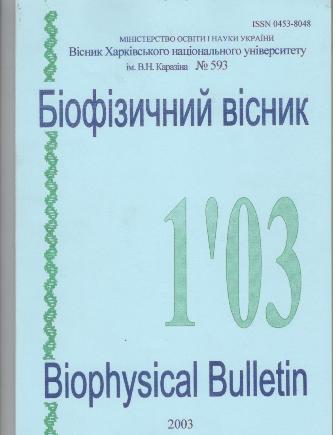ИК спектроскопическое исследование действия ионов Cu2+на конформационное состояние ДНК
Анотація
Методом ИК спектроскопии изучено взаимодействие ионов Cu2+ (при [Cu2+]/[P]=0,2+0,8) с молекулой ДНК в водных растворах ([P]=6•10-2М) в диапазоне температур 26 ионы Cu2+, связываясь с фосфатными группами молекулы ДНК, вызывают значительное увеличение интенсивности спектра поглощения в области колебаний сахаро-фосфатной цепи, что свидетельствует о переходе ДНК в компактное состояние (в пределах В-формы). Однако, при соотношении [Cu2+]/[P] происходит частичная денатурация ДНК. Проведено исследование действия ионов Cu2+ на устойчивость вторичной структуры ДНК к изменению температуры. Установлено, что температура перехода спираль-клубок ДНК понижается с увеличением концентрации ионов Cu2+ , причем эта зависимость имеет существенно нелинейный характер, что, по-видимому, определяется наложением эффектов, обусловленных связыванием Cu2+ с фосфатными группами и азотистыми основаниями.
Завантаження
Посилання
Blagoi IuP, Galkin VL, Gladchenko GO, Kornilova SV, Sorokin VA, Shkolrbatov AG. Metallokompleksy nukleinovykh kislot v rastvorakh. Kiev: Nauk. dumka; 1991. 272p. (in Russian)
Schultz J, Ruppecht A, Song Z, Piskyr J, Nordenskioid L, Lahajnar G. Bioph. J. 1994;66:810-9.
Kornilova SV, Sorokin VA, Blagoi IuP, Valeev VA, Arutiunian SG. Izuchenie vzaimodeistviia DNK s ionami dvukhvalentnykh metallov. Mol. biologiia. 1991;25(3):648-57. (in Russian)
Blagoi YuP, Kornilova SV, Shkorbatov AG, Egupov SA. Stud. Biophysica. 1985;108(1):17-24.
Hackl E, Kornilova S, Kapinos L. J. Mol. Struct. 1997;408/409:229-32.
Hackl E, Kornilova S, Blagoi YuP. Metal Ions in biology and medicine. 1998;5:74-9.
Khakl EV, Kornilova IuP, Blagoi IuP. Biofizicheskii vestnik. 1998;1:62-70. (in Russian)
Akhrem AA, Egorova EP, Egorov AS. Biopolimery i kletka. 1989;5(5):44-8. (in Russian)
Muller W, Crothers DM. Eur. J. Biochem. 1975;54:267-7.
Fishman E. Appl. Opt. 1962;1:493.
Maleev VIa, Semenov MA. Biofizika. 1971;16(3):289-97. (in Russian)
Babushkin AA, Bazhulin PA, Korolev FV. Metody spektralnogo analiza. Moskva:MGU; 1962. 273p. (in Russian)
Taillandier E, Liquier J. Methods in enzimol. 1990;211:307-35.
Kornilova S, Hackl E, Kapinos L. Acta Biochim. Polon. 1998;45(1):107-17.
Ma C, Bloomfield V. Biophys. J. 1994;67:1678-81.
Benbasat JA. Biochemisty. 1984;23:3609-19.
Zundel G. Proton polarizability of hydrogen bonds. Series of lectures. Zalzburg. 1997. 250p.
Sissoeff J, Grisvaldt J, Cuile E. Prog. Biophis. And Mol. Biol. 1976;31(2):165-99.
Автори, які публікуються у цьому журналі, погоджуються з наступними умовами:
- Автори залишають за собою право на авторство своєї роботи та передають журналу право першої публікації цієї роботи на умовах ліцензії Creative Commons Attribution License, котра дозволяє іншим особам вільно розповсюджувати опубліковану роботу з обов'язковим посиланням на авторів оригінальної роботи та першу публікацію роботи у цьому журналі.
- Автори мають право укладати самостійні додаткові угоди щодо неексклюзивного розповсюдження роботи у тому вигляді, в якому вона була опублікована цим журналом (наприклад, розміщувати роботу в електронному сховищі установи або публікувати у складі монографії), за умови збереження посилання на першу публікацію роботи у цьому журналі.
- Політика журналу дозволяє і заохочує розміщення авторами в мережі Інтернет (наприклад, у сховищах установ або на особистих веб-сайтах) рукопису роботи, як до подання цього рукопису до редакції, так і під час його редакційного опрацювання, оскільки це сприяє виникненню продуктивної наукової дискусії та позитивно позначається на оперативності та динаміці цитування опублікованої роботи (див. The Effect of Open Access).




